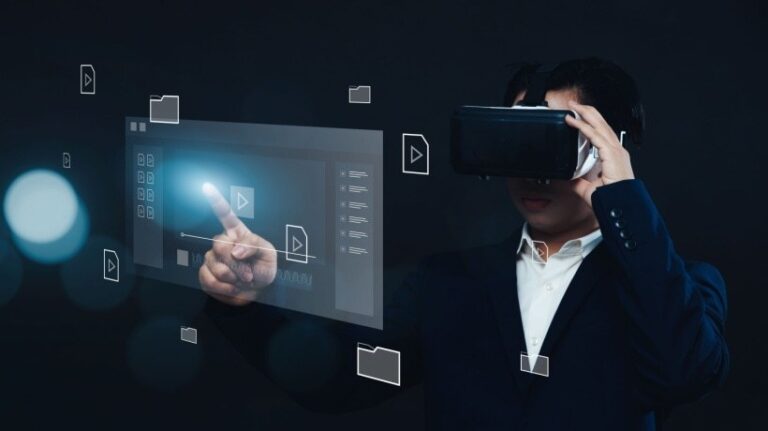
Microlearning using AR and VR
Microlearning swept the world of e-learning, providing a short, intensive and effective learning experience for busy professionals and learners. As technology evolves, augmented reality (AR) and virtual reality (VR) are blending with microlearning, creating powerful new opportunities for immersive and interactive training. However, this combination also has its own unique challenges that need to be managed carefully.
How AR and VR enhance microlearning
1. Immersive learning experience
AR and VR provide learners with practical and experiential training that involves multiple senses. This allows users to interact with realistic simulations and virtual overlays that reflect real-world scenarios, making learning more impactful.
2. Scenario-based training
Microlearning modules provided through VR can simulate high pressure situations such as handling emergency situations, performing surgical procedures, navigating complex machines, and more. AR, on the other hand, overlays instructional content in a real environment, allowing learners to practice while interacting with physical objects.
3. Higher engagement and retention
The immersive nature of AR and VR captures the full attention of learners, ensuring they remain involved and retain information better. This is especially useful for skill-based training where active participation is important.
4. Tailored and interactive content
Both AR and VR can provide a personalized, on-demand learning experience. Learners can advance at their own pace, receive feedback, and adjust their approach in real time.
Examples of AR and VR in Microlearning
Technical and procedural training
VR modules enable experts to safely implement complex procedures, especially in safe areas such as healthcare, pharmaceuticals and high-risk industrial environments. From surgical simulations to handling hazardous materials, learners can hone their skills in a controlled, risk-free environment before applying them to real-world scenarios. On the Job Support
AR provides real-time hands-free guidance by overlaying step-by-step instructions, safety alerts, or diagnostics directly onto the instrument. This reduces errors and increases the efficiency of technical, medical and manufacturing settings. Soft Skill Development
VR scenarios are immersed in realistic customer interactions, leadership challenges, or conflict resolution exercises, including escalation training for law enforcement and emergency responders. This allows for safe and repeatable practice in high stakes situations, improving decision-making and communication skills.
AR and VR pros in microlearning
Real World Applications
Learners can practice in a realistic environment and gain confidence before applying skills to their work. engagement
An immersive experience will help learners stay focused and invested in content. Retention improvements
Active participation in AR/VR scenarios enhances memory retention. Safety and cost-effective
Simulating dangerous or expensive training scenarios eliminates actual risk and reduces costs over time. Personalized learning
AI-driven VR/AR systems can adapt to the needs of individual learners and provide tailored experiences.
The challenges of combining AR/VR with microlearning
Module length and setup time
Microlearning is intended for 5-10 minutes, but VR/AR modules often require a slightly longer period of time to provide full value. Additionally, wearing a headset or configuring an AR device can take time and confuse the quick and simple philosophy of microlearning. Mobility Limitations
Traditional microlearning thrives in mobile accessibility. However, VR often requires dedicated equipment and space, reducing portable. AR solutions, although more mobile-friendly, can depend on your specific device and environment. Implementation cost
Development and deployment of AR/VR training can be expensive at first and requires investment in hardware, software and content creation. User learning curve
Not all learners are tech-savvy and some face challenges to adapt to VR/AR tools. It is essential to provide the right support and training.
Balance between dipping and accessibility
To overcome these challenges, the organization:
Use VR/AR selectively
Book immersive modules for training scenarios where practical practice is important, such as high-risk and skill-based training. Take advantage of portable solutions
Maximize accessibility by choosing a standalone VR headset or AR app that works on your smartphone or tablet. Integrate with existing strategies
Complement VR/AR microlearning using traditional mobile modules on topics that do not require immersion. Streamline your setup
Preconfigure your devices and create an intuitive interface that minimizes setup time and entry barriers.
The Future of Microlearning Using AR and VR
The convergence of AR, VR, and microlearning represents an exciting frontier of e-learning. As standalone VR devices and mobile AR solutions become more accessible, the line between immersive training and convenience will become blurred, allowing learners to participate in cutting-edge content anytime, anywhere. Furthermore, innovations like AI-driven personalization and 5G connectivity accelerate the adoption of these technologies.
Why AR/VR microlearning is important for organizations
If your organization is looking to strengthen its training and development strategies, AR, VR and microlearning combine to offer unparalleled possibilities. By creating an engaging, practical and immersive experience, you can ensure that learners are well prepared for real challenges, while maximizing ROI with eLearning Initiatives.
The future of microlearning is here, and it is immersive, engaging and transformative. Let’s shape the next generation of learning together!
Athiya Global
Unlock affordable custom learning solutions with Athiya Global. It offers interactive modules that enhance learning while seamlessly integrating with your LMS. Experience cost-effective quality.
Originally published on www.linkedin.com
Source link


